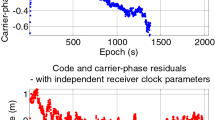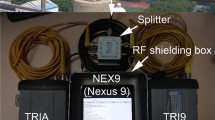Abstract
Developers targeting Android platforms can obtain raw GNSS measurements, which can achieve submeter or even decimeter-level positioning accuracy. An accurate receiver measurement error model is an important prerequisite for precise positioning with smart devices. Therefore, we analyzed the measurement error characteristics of raw GNSS data from smart devices using both embedded and external antennas. We find that the GNSS signals produced by smart devices have non-uniform signal strengths, rapid C/N0 variations, and low C/N0 at high elevations. The pseudorange noise is about 10 times larger than that from geodetic receivers; the carrier phase noise of Nexus 9 is 3–5 times larger than that of geodetic receivers, and unexpectedly is half of that of μ-blox. We provide theoretical parameters for the noise versus C/N0 models of the GNSS chipset for different smart devices. Unfortunately, the carrier phase tracking of Samsung Galaxy S8 and Huawei Honor v8 are discontinuous due to the duty-cycle issue, which results in greater noise and carrier phase unavailability. Moreover, we found two unique error characteristics of the carrier phase available from Nexus 9 anomalous “jagged” distribution and random initial phase biases, which is evident in the controlled environment test. Finally, we obtained promising positioning results: the horizontal and vertical RMS of pseudorange single-point positioning are about 10–20 m; the static carrier phase relative positioning (CRP) solutions of Nexus 9 can achieve centimeter-level precision, whereas both horizontal and vertical STDs are about 1 cm or better but with decimeter-level biases. When using an external antenna, the resulting biases are as small as a few centimeters. Encouragingly, the actual vehicle test results showed that the STD of the Nexus 9 kinematic CRP 3D-distance error is 0.169 m, and the percentages of errors falling into ± 0.1 m and ± 0.5 m are 63.59% and 100%, respectively. Furthermore, multi-GNSS is able to provide more reliable position services in GNSS-adverse environments.














Similar content being viewed by others
References
Banville S, Diggelen FV (2016) Precise GNSS for everyone: precise positioning using raw GPS measurements from android smartphones. GPS World 27(11):43–48
Geng J, Li G, Zeng R, Wen Q, Jiang E (2018) A Comprehensive assessment of raw multi-GNSS measurements from mainstream portable smart devices. In: Proceedings of ION GNSS 2018, Institute of Navigation, Miami, Florida, USA, Sept 24–28, pp 392–412
Gogoi N, Minetto A, Linty N, Dovis F (2019) A controlled-environment quality assessment of android GNSS raw measurements. Electronics 8(1):5. https://doi.org/10.3390/electronics8010005
Håkansson M (2018) Characterization of GNSS observations from a Nexus 9 android tablet. GPS Solut 23(1):21. https://doi.org/10.1007/s10291-018-0818-7
Humphreys TE, Murrian M, Diggelen FV, Podshivalov S, Pesyna KM (2016) On the feasibility of cm-accurate positioning via a smartphone’s antenna and GNSS chip. In: Proceedings of IEEE/ION PLANS 2016, Savannah, GA, USA, 11–14 Apr 2016, pp 232–242
Hwang J, Yun H, Suh Y, Cho J, Lee D (2012) Development of an RTK-GPS positioning application with an improved position error model for smartphones. Sensors (Basel, Switzerland) 12(10):12988–13001. https://doi.org/10.3390/s121012988
Joseph A (2010) What is the difference between SNR and C/N0? InsideGNSS 5:20–25
Kaplan ED, Hegarty C (2017) Understanding GPS/GNSS: principles and applications, 3rd edn. Artech House Publishers, London
Laurichesse D, Rouch C, Marmet FX, Pascaud M (2017) Smartphone applications for precise point positioning. In: Proceedings of ION GNSS 2017, Institute of Navigation, Portland, Oregon, USA, Sept 25–29, pp 171–187
Linty N, Presti LL, Dovis F, Crosta P (2014) Performance analysis of duty-cycle power saving techniques in GNSS mass-market receivers. In: Proceedings of PLANS 2014, Monterey, CA, USA, May 5–8, pp 1096–1104
Pesyna KM, Heath RW, Humphreys TE (2014) Centimeter positioning with a smartphone-quality GNSS antenna. In: Proceedings of ION GNSS 2014, Tampa, Florida, USA, Sept 8–12, pp 1568–1577
Pesyna KM, Humphreys TE, Heath RW, Novlan TD, Zhang JC (2017) Exploiting antenna motion for faster initialization of centimeter-accurate GNSS positioning with low-cost antennas. IEEE Trans Aerosp Electron Syst 53(4):1597–1613. https://doi.org/10.1109/TAES.2017.2665221
Pirazzi G, Mazzoni A, Biagi L, Crespi M (2017) Preliminary performance analysis with a GPS + Galileo enabled chipset embedded in a smartphone. In: Proceedings of ION GNSS 2017, Institute of Navigation, Portland, Oregon, USA, Sept 25–29, pp 101–115
Realini E, Caldera S, Pertusini L, Sampietro D (2017) Precise GNSS positioning using smart devices. Sensors 17(10):2434. https://doi.org/10.3390/s17102434
Riley S, Lentz W, Clare A (2017) On the path to precision—observations with android GNSS observables. In: Proceedings of ION GNSS 2017, Institute of Navigation, Portland, Oregon, USA, Sept 25–29, pp 116–129
Shin D, Lim C, Park B, Yun Y, Kim E, Kee C (2017) Single-frequency divergence-free hatch filter for the android N GNSS raw measurements. In: Proceedings of ION GNSS 2017, Institute of Navigation, Portland, Oregon, USA, Sept 25–29, pp 188–225
Van Dierendonck AJ, Fenton P, Ford T (1992) Theory and performance of narrow correlator spacing in a GPS receiver. Navigation 39(3):265–283
Zhang Y, Yao Y, Yu J, Chen X, Zeng Y, He N (2013) Design of a novel quad-band circularly polarized handset antenna. In: Proceedings of the international symposium on antennas & propagation, Nanjing, China, Oct 23–25, pp 146–148
Zhang X, Tao X, Zhu F, Shi X, Wang F (2018) Quality assessment of GNSS observations from an android N smartphone and positioning performance analysis using time-differenced filtering approach. GPS Solut 22(3):70. https://doi.org/10.1007/s10291-018-0736-8
Acknowledgements
This work is funded by the National Key R&D Program of China (2018YFC1504002, 2016YFB0501802). We used Google developed GNSS Logger apps to obtain GNSS data from smart devices. We thank two anonymous reviewers for their valuable comments.
Author information
Authors and Affiliations
Corresponding author
Additional information
Publisher's Note
Springer Nature remains neutral with regard to jurisdictional claims in published maps and institutional affiliations.
Rights and permissions
About this article
Cite this article
Li, G., Geng, J. Characteristics of raw multi-GNSS measurement error from Google Android smart devices. GPS Solut 23, 90 (2019). https://doi.org/10.1007/s10291-019-0885-4
Received:
Accepted:
Published:
DOI: https://doi.org/10.1007/s10291-019-0885-4




